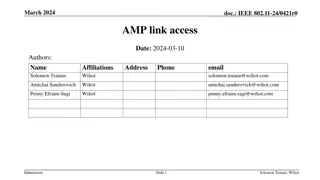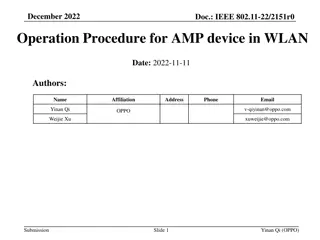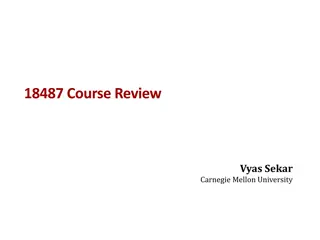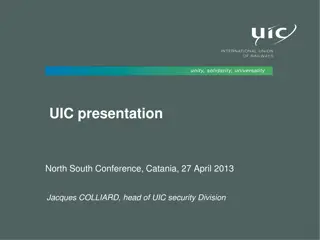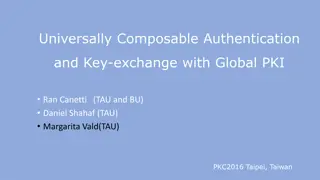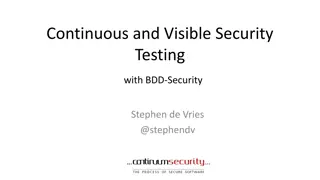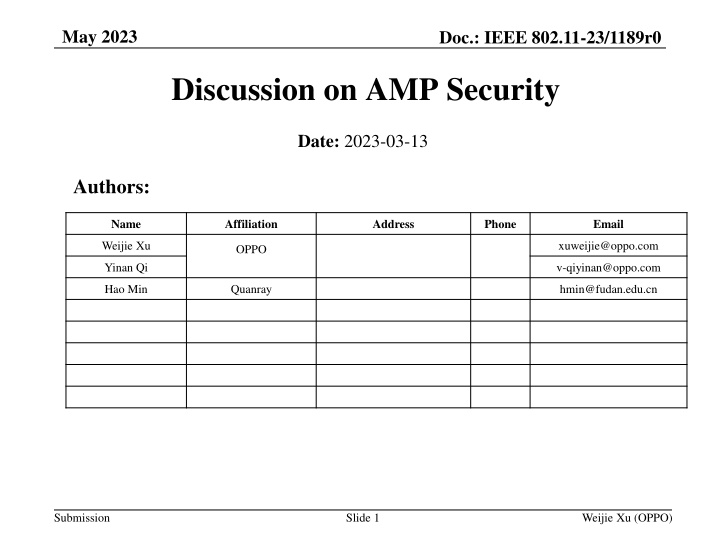
AMP Security Review and AES-128 Power Consumption Analysis
Explore the proposal to review security mechanisms for AMP in IoT, focusing on AES-128 encryption power consumption. The study aims to assess the feasibility of reusing WiFi security protocols for AMP devices in IEEE 802.11 standards, ensuring user privacy and data security in ultra-low power consumption scenarios.
Download Presentation

Please find below an Image/Link to download the presentation.
The content on the website is provided AS IS for your information and personal use only. It may not be sold, licensed, or shared on other websites without obtaining consent from the author. If you encounter any issues during the download, it is possible that the publisher has removed the file from their server.
You are allowed to download the files provided on this website for personal or commercial use, subject to the condition that they are used lawfully. All files are the property of their respective owners.
The content on the website is provided AS IS for your information and personal use only. It may not be sold, licensed, or shared on other websites without obtaining consent from the author.
E N D
Presentation Transcript
May 2023 Doc.: IEEE 802.11-23/1189r0 Discussion on AMP Security Date: 2023-03-13 Authors: Name Affiliation Address Phone Email Weijie Xu xuweijie@oppo.com OPPO Yinan Qi v-qiyinan@oppo.com Hao Min Quanray hmin@fudan.edu.cn Submission Slide 1 Weijie Xu (OPPO)
Doc.: IEEE 802.11-23/1189r0 May 2023 Abstract It is proposed during the TIG phase[1][2] to review the security mechanism for AMP and check whether the existing WiFi security can be reused for AMP. In this submission, the power consumption of encryption algorithm AES 128 is tested. Submission Slide 2 Weijie Xu (OPPO)
Doc.: IEEE 802.11-23/1189r0 May 2023 Background User privacy and data security needs to be protected in many of the use cases identified for AMP IoT[3]. e.g. the information wrote into and read from the AMP tag used in logistics use cases e.g. in the use case of finding home belongings, the location information of personal belongings shall not be exposed to the unauthorised devices On the other hand, there is strict constraint of device complexity and power consumption for AMP devices, it needs to check whether the existing security can be reused when supporting AMP IoT in 802.11. AES 128 is the main encryption/decryption algorithm used in WiFi. Submission Slide 3 Weijie Xu (OPPO)
Doc.: IEEE 802.11-23/1189r0 May 2023 Baseband Architecture In order to measure the power consumption of AES128, the following baseband architecture is designed. CLK-in Clock management AES Data-in Decoding Control CRC Buffer Data-out Manchester coding EEPROM Figure 1 Baseband Architecture Submission Slide 4 Weijie Xu (OPPO)
Doc.: IEEE 802.11-23/1189r0 May 2023 Testing of AES128 Chip process: 65nm. Packet length:128bits(cleartext or ciphertext) Figure 2 Testing of encryption using AES 128 Figure 3: baseband layout Power consumption test result: 3.8 uW/6.5uW for AES module/whole chip. Submission Slide 5 Weijie Xu (OPPO)
Doc.: IEEE 802.11-23/1189r0 May 2023 Summary In this submission, the power consumption of AES 128 in a ultra- low power consumption baseband platform is tested. It can be seen very low power consumption (i.e. several uW) can be achieved for encryption/decryption using AES 128 hardware accelerator. It is proposed to use the exiting WiFi security as the starting point for AMP IoT. Submission Slide 6 Weijie Xu (OPPO)
May 2023 Doc.: IEEE 802.11-23/1189r0 Reference 1. IEEE 802.11-23/0063r4, Proposal for consensus straw poll 2. IEEE 802.11-23/0406r0 Proposal for consensus straw poll and motion 3. IEEE 802.11-23/0436r0 Technical Report on support of AMP IoT devices in WLAN Submission Slide 7 Weijie Xu (OPPO)












